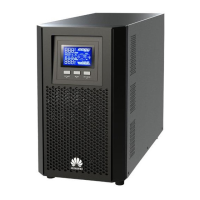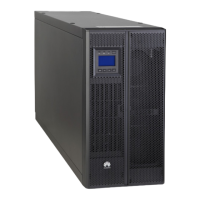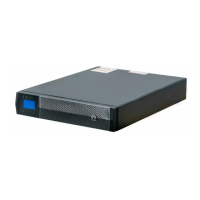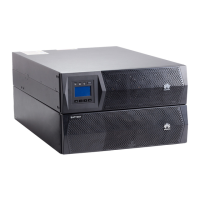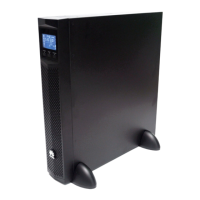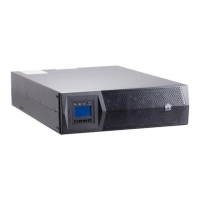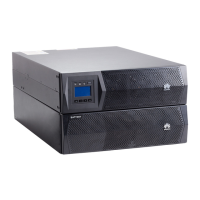Do you have a question about the Huawei UPS2000-G-6 kVA and is the answer not in the manual?
Describes the UPS2000-G in terms of features, performance, appearance, structure, working principle, installation, operation, and maintenance.
Lists the target users for this document, including sales, support, system, installation, commissioning, configuration, and maintenance engineers.
Defines the safety symbols (DANGER, WARNING, CAUTION, NOTICE) used throughout the document.
Provides essential safety guidelines for installing, maintaining, and operating the UPS, emphasizing trained personnel.
Specifies requirements for personnel performing UPS installation and maintenance, including training and authorization.
Details the requirements for grounding devices, including installing the ground cable first and ensuring secure grounding.
Outlines personal safety measures, such as avoiding thunderstorms, preventing electric shocks, and using ESD protection.
Covers safety aspects related to the UPS device itself, like anchoring, ventilation, and avoiding modifications.
Addresses high voltage hazards, AC facility operations, and compliance with laws and regulations for electrical safety.
Explains high leakage current phenomena and recommendations for circuit breaker selection to prevent electric shocks.
Provides safety precautions for handling power cables, including installation, removal, and connection procedures.
Advises on the correct replacement of fuses to ensure system safety and prevent damage.
Details precautions to prevent damage to sensitive components from static electricity, including ESD protection measures.
Warns against water leakage and condensation, and outlines immediate actions if liquid is detected inside the product.
Specifies the suitable operating environment for the UPS, including temperature, humidity, and avoiding hazardous conditions.
Covers crucial safety precautions for handling and operating batteries, including preventing short circuits and electrolyte leakage.
Addresses safety measures related to moving sharp or heavy objects and handling fans to prevent injuries.
Provides guidelines for safe and proper cable installation, including binding, temperature considerations, and distances.
Describes the different UPS models covered by the document and their represented by nomenclature.
Explains the fundamental working principles of the UPS, including conceptual diagrams and operational modes.
Presents the physical appearance of the UPS units through front and rear view diagrams.
Lists and describes optional components that can be used with the UPS, detailing their models, functions, and remarks.
Covers essential preparations for UPS installation, including site selection, floor bearing, environment, and tools.
Lists the necessary tools for UPS installation, emphasizing the use of insulated tools for safety.
Details recommended power cable specifications, including cross-sectional area, terminal type, and torque for various UPS models.
Provides a procedure for unpacking the UPS and checking for shipping damage or discrepancies.
Outlines the steps for UPS installation, covering mechanical installation and cable connection for tower or rack mounting.
Explains the need for and installation of backfeed protection devices to prevent electric shocks.
Illustrates feedback prevention connections using dry contract control for different UPS configurations.
Lists post-installation check items to ensure proper installation, including cable routing, connections, and ground cable integrity.
Introduces the UPS control panel, its functions for controlling operation, displaying data, and setting parameters.
Describes the indicators on the control panel, their colors, status, and meanings.
Explains the function of each button on the control panel for operating the UPS and navigating menus.
Details the function of the LCD display for showing UPS running data, alarms, and parameter settings.
Illustrates the different screens displayed during UPS startup, including initial and non-initial startup sequences.
Provides step-by-step instructions for starting the UPS in normal mode, covering initial and non-initial startups.
Guides on how to start the UPS in battery mode, including initial and non-initial startup procedures.
Shows the hierarchical structure of the LCD menus, allowing users to navigate through various settings and information.
Details how to access and interpret the status screens, including Mains Input, Bypass Input, Battery Status, Inverter Output, UPS Output, Local-UPS Load, Parallel-System Load, and Environment Monitoring.
Explains how to view and manage alarms, including active, historical, sorting, and clearing alarms.
Guides on accessing and configuring various settings, including basic settings, communication cards, system parameters, and battery parameters.
Describes how to use the Control screen for UPS operations like starting, shutting down, battery maintenance, and parameter synchronization.
Explains how to view UPS model, ESN, and software version information from the About screen.
Lists critical checks to perform before powering on the UPS to ensure safe and correct operation.
Covers basic operations for a single UPS, including starting, shutting down, and performing EPO.
Explains how to perform operations on a parallel UPS system, including starting, shutting down, and EPO.
Introduces the optional communication cards available for the UPS, such as SNMP, Modbus, and dry contact cards.
Details the functions and features of the SNMP card for remote UPS monitoring and management.
Describes the Modbus card and its networking capabilities for remote UPS management via RS485.
Explains the functionality of the dry contact card for providing alarm outputs and control inputs.
Describes the external dry contact card's capabilities for providing additional dry contact outputs and inputs.
Outlines routine maintenance items for the UPS, including operating environment checks, control panel verification, cleanliness, and parameter checks.
Covers crucial aspects of battery maintenance, including safety precautions, routine checks, and procedures for maintaining battery health.
Provides a table of common UPS faults, their possible causes, and recommended measures for resolution.
Lists the physical dimensions and weight of the UPS units for different kVA ratings.
Details the environmental operating conditions for the UPS, including temperature, humidity, and altitude.
Provides electrical specifications for the UPS mains input, including power cable requirements, rated voltage, and input voltage range.
Outlines the bypass input electrical specifications, such as voltage and frequency tolerance, and overload capability.
Details the electrical specifications for the UPS output, including rated voltage, output voltage tolerance, and inverter overload capability.
Lists battery specifications, including rated voltage, number of batteries, leakage current, and charger parameters.
Describes the ECO (Economy Control Operation) feature, including voltage and frequency tolerance settings.
Explains the parallel operation capabilities of the UPS, including the number of UPSs that can be connected in parallel.
Lists the safety regulations and EMC standards that the UPS complies with, along with remarks on compliance.
Outlines the main menu structure of the UPS LCD, allowing navigation to various submenus and settings.
Details the information available on the Status screens, including input, output, battery, load, and environment monitoring data.
Explains how to access and interpret alarm information, covering active, historical, sorted, and clear alarms.
Guides on accessing and configuring various settings, including basic settings, communication cards, system parameters, and battery parameters.
Describes how to use the Control screen for UPS operations like starting, shutting down, battery maintenance, and parameter synchronization.
Provides steps to clear the "Batt. maint. notif" alarm and cancel the battery maintenance notification function.
Explains the purpose of the shallow discharge test for evaluating battery reliability and short-time backup capacity.
Details the steps for performing a shallow discharge test, including checking battery status, adjusting discharge ratio, and starting/stopping the test.
Describes the capacity test method to evaluate battery real-time capability and long-time backup capability.
Outlines the process for conducting a capacity test, including checking battery status, adjusting load rate, and starting/stopping the test.
Describes the UPS2000-G in terms of features, performance, appearance, structure, working principle, installation, operation, and maintenance.
Lists the target users for this document, including sales, support, system, installation, commissioning, configuration, and maintenance engineers.
Defines the safety symbols (DANGER, WARNING, CAUTION, NOTICE) used throughout the document.
Provides essential safety guidelines for installing, maintaining, and operating the UPS, emphasizing trained personnel.
Specifies requirements for personnel performing UPS installation and maintenance, including training and authorization.
Details the requirements for grounding devices, including installing the ground cable first and ensuring secure grounding.
Outlines personal safety measures, such as avoiding thunderstorms, preventing electric shocks, and using ESD protection.
Covers safety aspects related to the UPS device itself, like anchoring, ventilation, and avoiding modifications.
Addresses high voltage hazards, AC facility operations, and compliance with laws and regulations for electrical safety.
Explains high leakage current phenomena and recommendations for circuit breaker selection to prevent electric shocks.
Provides safety precautions for handling power cables, including installation, removal, and connection procedures.
Advises on the correct replacement of fuses to ensure system safety and prevent damage.
Details precautions to prevent damage to sensitive components from static electricity, including ESD protection measures.
Warns against water leakage and condensation, and outlines immediate actions if liquid is detected inside the product.
Specifies the suitable operating environment for the UPS, including temperature, humidity, and avoiding hazardous conditions.
Covers crucial safety precautions for handling and operating batteries, including preventing short circuits and electrolyte leakage.
Addresses safety measures related to moving sharp or heavy objects and handling fans to prevent injuries.
Provides guidelines for safe and proper cable installation, including binding, temperature considerations, and distances.
Describes the different UPS models covered by the document and their represented by nomenclature.
Explains the fundamental working principles of the UPS, including conceptual diagrams and operational modes.
Presents the physical appearance of the UPS units through front and rear view diagrams.
Lists and describes optional components that can be used with the UPS, detailing their models, functions, and remarks.
Covers essential preparations for UPS installation, including site selection, floor bearing, environment, and tools.
Lists the necessary tools for UPS installation, emphasizing the use of insulated tools for safety.
Details recommended power cable specifications, including cross-sectional area, terminal type, and torque for various UPS models.
Provides a procedure for unpacking the UPS and checking for shipping damage or discrepancies.
Outlines the steps for UPS installation, covering mechanical installation and cable connection for tower or rack mounting.
Explains the need for and installation of backfeed protection devices to prevent electric shocks.
Illustrates feedback prevention connections using dry contract control for different UPS configurations.
Lists post-installation check items to ensure proper installation, including cable routing, connections, and ground cable integrity.
Introduces the UPS control panel, its functions for controlling operation, displaying data, and setting parameters.
Describes the indicators on the control panel, their colors, status, and meanings.
Explains the function of each button on the control panel for operating the UPS and navigating menus.
Details the function of the LCD display for showing UPS running data, alarms, and parameter settings.
Illustrates the different screens displayed during UPS startup, including initial and non-initial startup sequences.
Provides step-by-step instructions for starting the UPS in normal mode, covering initial and non-initial startups.
Guides on how to start the UPS in battery mode, including initial and non-initial startup procedures.
Shows the hierarchical structure of the LCD menus, allowing users to navigate through various settings and information.
Details how to access and interpret the status screens, including Mains Input, Bypass Input, Battery Status, Inverter Output, UPS Output, Local-UPS Load, Parallel-System Load, and Environment Monitoring.
Explains how to view and manage alarms, including active, historical, sorting, and clearing alarms.
Guides on accessing and configuring various settings, including basic settings, communication cards, system parameters, and battery parameters.
Describes how to use the Control screen for UPS operations like starting, shutting down, battery maintenance, and parameter synchronization.
Explains how to view UPS model, ESN, and software version information from the About screen.
Lists critical checks to perform before powering on the UPS to ensure safe and correct operation.
Covers basic operations for a single UPS, including starting, shutting down, and performing EPO.
Explains how to perform operations on a parallel UPS system, including starting, shutting down, and EPO.
Introduces the optional communication cards available for the UPS, such as SNMP, Modbus, and dry contact cards.
Details the functions and features of the SNMP card for remote UPS monitoring and management.
Describes the Modbus card and its networking capabilities for remote UPS management via RS485.
Explains the functionality of the dry contact card for providing alarm outputs and control inputs.
Describes the external dry contact card's capabilities for providing additional dry contact outputs and inputs.
Outlines routine maintenance items for the UPS, including operating environment checks, control panel verification, cleanliness, and parameter checks.
Covers crucial aspects of battery maintenance, including safety precautions, routine checks, and procedures for maintaining battery health.
Provides a table of common UPS faults, their possible causes, and recommended measures for resolution.
Lists the physical dimensions and weight of the UPS units for different kVA ratings.
Details the environmental operating conditions for the UPS, including temperature, humidity, and altitude.
Provides electrical specifications for the UPS mains input, including power cable requirements, rated voltage, and input voltage range.
Outlines the bypass input electrical specifications, such as voltage and frequency tolerance, and overload capability.
Details the electrical specifications for the UPS output, including rated voltage, output voltage tolerance, and inverter overload capability.
Lists battery specifications, including rated voltage, number of batteries, leakage current, and charger parameters.
Describes the ECO (Economy Control Operation) feature, including voltage and frequency tolerance settings.
Explains the parallel operation capabilities of the UPS, including the number of UPSs that can be connected in parallel.
Lists the safety regulations and EMC standards that the UPS complies with, along with remarks on compliance.
Outlines the main menu structure of the UPS LCD, allowing navigation to various submenus and settings.
Details the information available on the Status screens, including input, output, battery, load, and environment monitoring data.
Explains how to access and interpret alarm information, covering active, historical, sorted, and clear alarms.
Guides on accessing and configuring various settings, including basic settings, communication cards, system parameters, and battery parameters.
Describes how to use the Control screen for UPS operations like starting, shutting down, battery maintenance, and parameter synchronization.
Provides steps to clear the "Batt. maint. notif" alarm and cancel the battery maintenance notification function.
Explains the purpose of the shallow discharge test for evaluating battery reliability and short-time backup capacity.
Details the steps for performing a shallow discharge test, including checking battery status, adjusting discharge ratio, and starting/stopping the test.
Describes the capacity test method to evaluate battery real-time capability and long-time backup capability.
Outlines the process for conducting a capacity test, including checking battery status, adjusting load rate, and starting/stopping the test.
| Model | UPS2000-G-6 kVA |
|---|---|
| Power Rating | 6 kVA / 5.4 kW |
| Rated Capacity | 6 kVA |
| Capacity | 6 kVA |
| Input Frequency | 50/60 Hz |
| Output Frequency | 50/60 Hz |
| Waveform | Pure Sine Wave |
| Operating Temperature | 0°C to 40°C |
| Relative Humidity | 0% to 95% (non-condensing) |
| Input Voltage | 220/230/240 VAC |
| Input Frequency Range | 40 Hz–70 Hz |
| Output Voltage | 220/230/240 VAC |
| Battery Type | Sealed Maintenance Free |
| Communication Interface | RS232, USB, SNMP |
| Input Voltage Range | 160-280 VAC |
